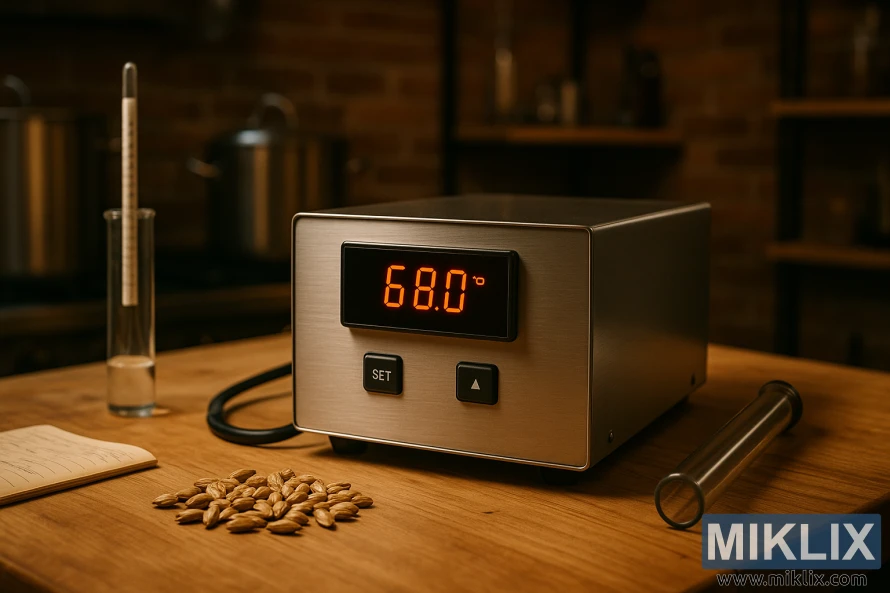Image: Fermentation temperature control unit
Published: July 21, 2025 at 2:55:14 PM UTC
Last updated: September 27, 2025 at 3:28:34 PM UTC
A sleek stainless steel fermentation control unit with digital display sits on a wooden workbench, highlighting precision and craft in home brewing pale ale.
On a sturdy wooden workbench that bears the marks of repeated use and quiet dedication, a sleek digital temperature controller sits at the center of a carefully curated brewing setup. Its stainless steel casing gleams under the warm, ambient lighting that fills the room, reflecting the golden tones of the surrounding space with a subtle, industrial elegance. The red LED display reads “68.0°C,” a precise measurement that signals the critical stage of mashing or early fermentation—where temperature control is not just a technical requirement but a defining factor in the flavor, clarity, and character of the final brew. The controller’s minimalist interface, with clearly labeled buttons and a responsive digital readout, suggests both ease of use and high functionality, embodying the intersection of modern engineering and artisanal brewing.
Surrounding the unit, an array of brewing tools is arranged with deliberate care. A graduated cylinder stands upright, its transparent walls etched with fine measurement markings, ready to assess wort gravity or liquid volumes with precision. Nearby, a glass sampling tube rests beside a small pile of barley grains—pale, golden, and slightly textured—hinting at the malt bill chosen for this particular batch. The grains are scattered just enough to suggest recent handling, their presence grounding the scene in the agricultural origins of brewing. A notepad lies open, its pages filled with handwritten notes and calculations, capturing the brewer’s observations, adjustments, and reflections. These scribbles are more than data—they are the narrative of a recipe in progress, a record of choices made and lessons learned.
In the background, stainless steel containers and shelving units line the walls, their surfaces clean and orderly. The shelves hold additional glassware, tubing, and perhaps a few bottles of finished product, each item contributing to the sense of a well-equipped and thoughtfully maintained workspace. The lighting, warm and directional, casts soft shadows that enhance the textures of wood, metal, and grain, creating a cozy yet professional atmosphere. The exposed brick wall behind the setup adds a touch of rustic charm, reinforcing the idea that this is a space where tradition and innovation coexist.
This image captures more than just a moment in the brewing process—it encapsulates the ethos of home brewing at its most refined. It speaks to the brewer’s commitment to precision, their understanding of the delicate balance between science and craft. Temperature control, as represented by the digital unit, is not merely about hitting a number—it’s about unlocking enzymatic activity, preserving yeast health, and shaping the sensory profile of the beer. In the case of a pale ale, maintaining the right temperature ensures that the malt’s subtle sweetness and biscuity notes are preserved, while hop bitterness and aroma are allowed to shine without overwhelming the palate.
The overall composition conveys a sense of calm focus, of a brewer deeply engaged in their craft. It is a portrait of intentionality, where every tool has its place and every measurement has meaning. From the gleam of the controller to the handwritten notes, from the scattered grains to the ambient glow, the scene invites the viewer into a world where brewing is not just a hobby or a profession—it is a ritual, a pursuit of excellence, and a celebration of flavor born from thoughtful control and creative expression.
The image is related to: Brewing Beer with Pale Ale Malt

